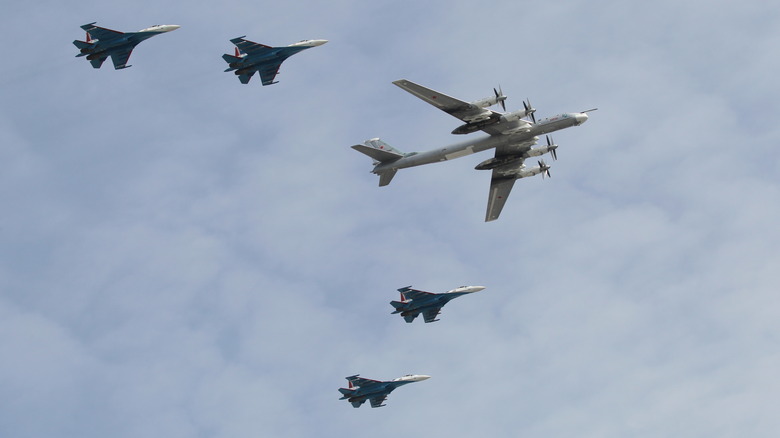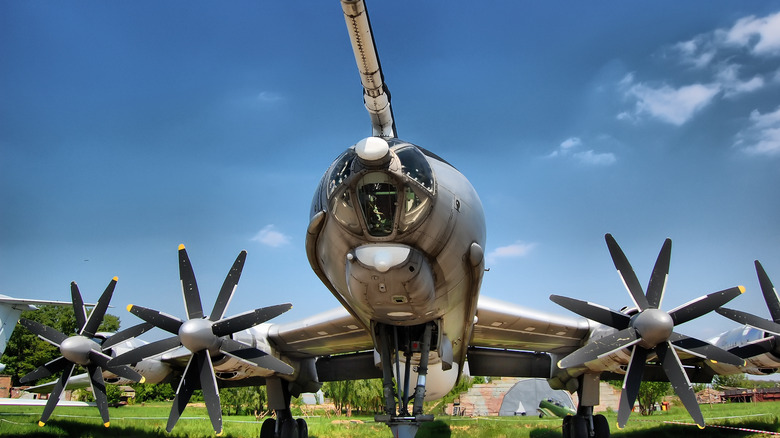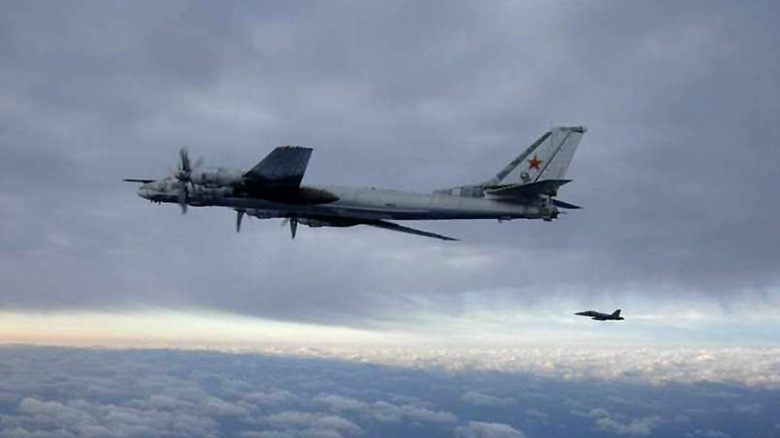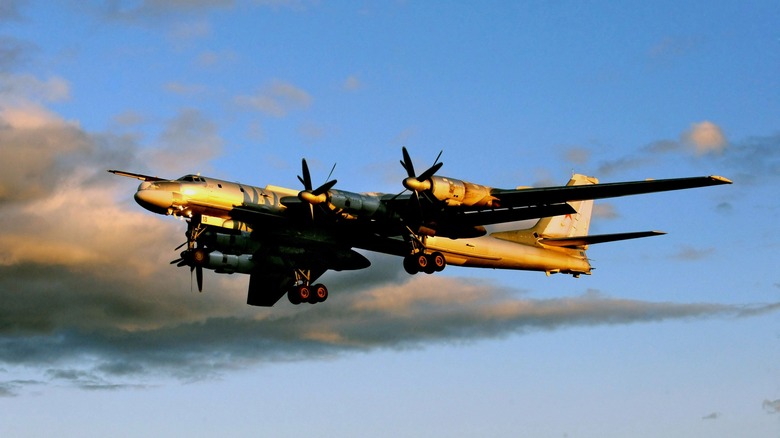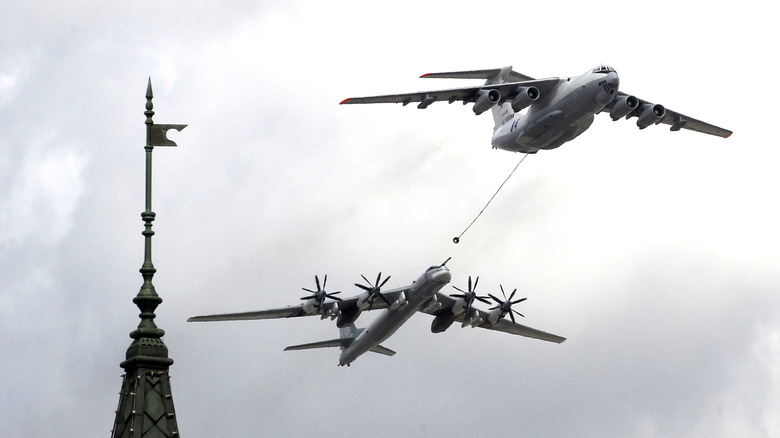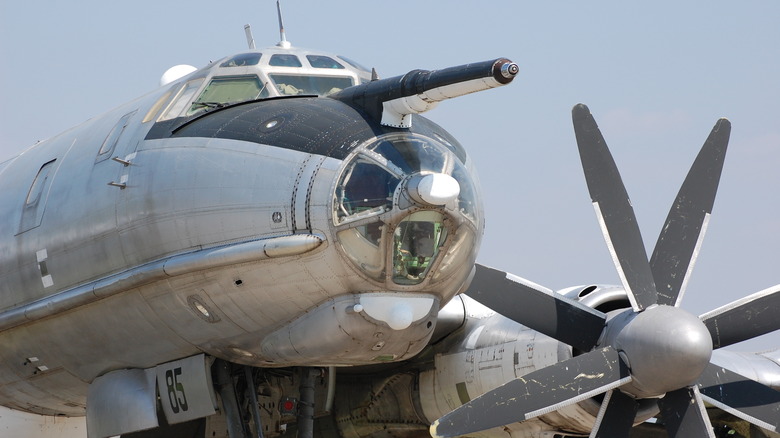The Massive Soviet Turboprop Bomber That's Been In Service Over 70 Years
The Soviet Union was well known for its creative and potent weapons development. Both the United States and the USSR spent decades trying to conceive new and inventive ways to kill one another if the time ever came to push the button. The Tu-95 is a behemoth turboprop aircraft that was purpose-built to do just that. Tu series aircraft were built by Tupolev and first appeared in the Soviet Union's arsenal in 1949. They were enormous bombers that could bring a truly unholy volume of conventional and nuclear armaments to the fight from vast distances.
What makes the Tu-95 special is the length of service it provided to the Soviet Union and now to Russia. When the Union dissolved in 1991, many Tu-95s were left behind in newly established (or reestablished) countries outside the boundaries of the Russian Federation. Some have made their way back, like those that had been stationed in Kazakhstan. Even considering their age, they remain a crucial tool in the arsenal of the Russian armed forces, and there's even a set of games that center on the commercial use of this type of aircraft (called TU-46 and TU-95).
Tupolev's early Tu-4 was a rip off of the B-29 Superfortress
The Soviet military was in desperate need of a long-range aerial attack option as the Second World War came to a close. The United States had developed the B-29 Superfortress shortly before entering the war, and it soon became the envy of the Soviets' eyes. As many as 1,000 B-29s were involved in bombing runs over Tokyo at a time, and the aircraft was primarily utilized in the Pacific theater as a result of the vast distances between islands along the corridor of fighting. The famed "Enola Gay" is a B-29 Superfortress. While the United States wouldn't share the design with allies, a few had crashed in Soviet territory during aerial operations, and the Soviets used these examples of the airplane's engineering to design their own. The Tupolev Tu-4 was the first long-range bomber to join the Soviet ranks, and it was virtually a direct copy of the B-29.
Shortly after developing the Tu-4, Tupolev introduced the Tu-85 and then the Tu-95, which was delivered to service in 1956. The aircraft was crewed by a team of seven servicemembers and could cover a range of about 7,150 miles (longer if augmented with aerial refueling capabilities). The aircraft could reach an altitude ceiling of about 40,000 feet.
The finished design utilized intuitive design features
The completed Tupolev Tu-95 utilized four turboprop engines rather than piston or jet engines. These turboprops were the only option for creating the massive force required to lift this enormous aircraft. Each one of the Kuznetsov NK-12 propellers creates 15,000 horsepower and utilizes a pair of propeller blades that spin in a counterrotation to one another. The use of opposing propellers counteracts the enormous torque that's created by a combined 60,000 horsepower of rapidly rotating engine (that would otherwise all revolve in the same direction). The propeller tips move faster than the speed of sound, and therefore the aircraft is obscenely loud – it can even be heard underwater by submarine crews. The vessel is 151 feet, 7 inches long, and has a wingspan of just over 164 feet. The wings are oriented at a 30-degree angle. The airplane can reach a top speed of 574 miles per hour and with in-air refueling, the Tu-95 can improve its range to 9,300 miles.
When it comes to onboard weapons systems, the Tu-95 certainly isn't lacking. The bomber can carry 33,000 pounds of cruise missiles in its weapons cargo bays. It can also be loaded with a catapult launch drum that can accommodate six Kh-55 Granite nuclear cruise missiles. And it's bulked out with one (or sometimes two) Afanasev Makarov (AM-23) autocannons in the tail to provide a lethal defensive feature while participating in a bombing or scouting mission.
The Tu-95 was designed as a long range nuclear bomber
A Tu-95 was used as the platform to drop a test munition that turned out to be the largest nuclear weapon ever detonated. The Tsar Bomba was retrofitted to the bottom of one of these aircraft in October 1961 and then dropped over a Soviet test site. The bomb was so large it wouldn't fit in the bomb bay onboard. The resulting explosion created a mushroom cloud that reached 42 miles up into the atmosphere above. Like many other weapons platforms developed during the Cold War, the Tu-95 was a special kind of grim reaper. This was a long-range aerial bombing platform that was specifically developed to deliver nuclear payloads far behind enemy lines. In this case, the target would have been the United States (or perhaps a NATO ally in continental Europe). The Tu-95 could, if left unimpeded, fly over the entire breadth of the contiguous United States, potentially delivering a nuclear detonation anywhere that might be deemed necessary and feasibly reachable.
In the same way that the United States developed the S-3 Viking to effectively hunt and destroy Soviet submarines (but never actually did attack one), the Soviet Union busied themselves with the implements of all-out war as a means of deterrence. The Tu-95 is one impressive example of this drive for maximum readiness.
Tupolev aircraft were most often used in sword rattling missions
While the Tupolev Tu-95 was conceived as a nuclear bomber, the aircraft rarely flew loaded with nuclear armaments. It certainly was used in the air regularly by the Soviet military, however. There was a fair volume of unconventional conflict in a veritable ring of warzones around the United States and the Soviet Union, but the primary means by which the two combatant superpowers engaged one another was in combat-adjacent displays of might. Instead of flying the Tu-95 over American cities and dropping bombs, the Soviets would buzz coastlines and Navy vessels to prove their combat readiness, in the event that circumstances changed and actual combat became a reality. This is the same display of power that American Navy and Air Force units engage in to this day. Recently, the same tactics were displayed by the Chinese military as a total of 71 fighter jets and drones flew over Taiwanese airspace across a 24-hour period in December 2022.
John Newlin, a Navy aviator, describes his experience flying opposite a Tu-95 near Gibraltar in 1966 to the Smithsonian Magazine. He notes that "Bear Watch" was a routine effort while Navy ships were deployed at this time. The Soviet Tupolev aircraft were "sometimes armed with missiles but primarily used for electronic surveillance," he says. Bear Watch was a day-long effort in which pilots on the aircraft carrier would remain on constant shift assignments in order to launch two VF-74 F-4 Phantoms, two VMF-451 Marine F-8 Crusaders, a VPF-62 F-8 photo aircraft, and a VAH-11 A-3 tanker, all within five minutes of the order.
The practice of conducting long-range patrols, including the plane of choice, was revived under the leadership of Vladimir Putin starting in 2007.
In 2015, Tu-95s participated in aerial combat for the first time
Starting in 2015, the Tu-95 was again recalled to duty. This time, the bomber was given aerial missions more in line with the aircraft's initial purpose. While it hasn't been deployed to carry nuclear armaments into combat, the Tu-95 participated in bombing operations throughout Syria as the Russian government made the decision to intervene in the Syrian civil war.
They were used, seemingly in retaliation against ISIS forces after the downing of a Russian commercial aircraft, Metrojet Flight 9268. Tu-95s and the later Tu-160s have both flow bombing missions in Syria starting after this attack and continuing until 2017. Specific targets have been difficult to identify in civilian circles; critics note that these bombing campaigns were drastically beneficial to the imperiled Assad regime, so ISIS positions may have only accounted for some of the Tu-95s' objectives. For instance, the Russian Ministry of Defense reported in 2017 that "Tu-95MS fired cruise missiles at objects of international terrorist groupings in Syria." The release goes on to note that Kh-101 cruise missiles were deployed to destroy "the most important ISIS and Jabhat al-Nusra objects located in the provinces of Deir ez-Zor and Idlib."
